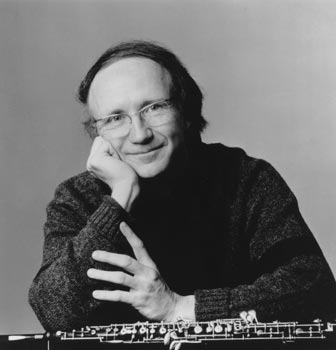|
Music takes many forms, and this very idea was embodied by Heinz Holliger himself, who spoke to us in the Lobby area of the Jane Mallett Theatre in Toronto.
Heinz Holliger is one of the greatest oboe players and soloists. Most of us in the audience knew that, I'm sure, but on this evening we also experienced, first-hand, Holliger's consuming interest in composition and conducting.
In fact, Holliger is less interested in playing oboe solos these days because — and it was somewhat disconcerting to hear him say this — he had nothing else to learn about playing the oboe. He'd discovered everything he could, and there was no more to explore.
|
|
But are these the 'ironic' statements of a 'musical genius'? or the 'permissable' opinions of a highly evolved artistic thinker? We'd receive a sound answer in the next few minutes, as the clock turned 7:50 pm, and Robert Aitken concluded that it was time for Heinz Holliger to, "wet his reed and play for us".
Holliger both played in and conducted the Oboe Quartet (2001) by Elliott Carter. Written for Holliger, this Quartet has become a standard part of his concert repertoire. Holliger's oboe enters in a series of single-note blasts, and these animate the bank of bowed strings — Fujiko Imajishi violin, Doug Perry viola, and David Hetherington cello — as they take turns providing accompaniment to the ensuing series of six duets. Each duet lasts a mere minute or two. Sudden silences slow things down to reveal the constituent parts of the composition, and when we hear a violin that's singing so high, we instead find it's the oboe. Gradually the alerts and the blasts subside and we are listening to a detailed and fluent conversation among four players. Then softly plucked strings. The end. Oboe Quartet (2001) is seemingly composed of fragments, aspects of sound experience; fragments which speak to our sense of the past as present history.
This concept of the fragment, the piece cast away from the whole, permeates the worlds of Holliger's composition, Puneiga (2000-2002). The raucous thunder sheet sounds: now we are in post-Apocalyptic, post-Holocaust worlds, and as mezzo-soprano Patricia Green's voice rises out of the ashes of broken civilization (the strings, woodwinds, brass, and percussion), there are recycling electronic sounds made by acoustic instruments, notes rub against each other in a microtonal world, and we sense this is a depiction of where civilization is today. Flutist Robert Aitken solos in the name of beauty and tenderness as he and clarinetist Max Christie fuse into a brightly moving stream where sound images intermittently reveal themselves. It's as if we're in the world of composer Hans Werner Henze.
Holliger's composition, Romancendres (2003), is a total change of pace. It's a duet for piano (David Swan) and cello (David Hetherington). Again, the preoccupation with making non-instrumental sounds into compositions is here from the start as Swan leans into the piano in order to mute the strings while hammering notes out on the keyboard with his left hand. Hetherington is thumping his thumb rhythmically on the neck of his cello. The mood is quiet and inward. Standard 'avant garde' fare? — but what Holliger has attempted is to imagine what Robert Schumann 's Five Romances for Cello and Piano sounded like. We'll never know because one day Schumann's wife, Clara, inexplicably burnt the manuscript. She thus reduced the Romances to cinders (cendres), hence Romancendres — a good example of Holliger's further creative absorption in the area of poetry and language.
Holliger's Turm-Musik (1984) brought 23 musicians onto the stage. As the strings massed up vertically, there was a sliding mobility to the horn and trumpet parts. As fingertips were rubbed around and around the rims of water-filled wine glasses and a glass bowl, an eerie pitch arose. When dipped into a container of water, the set of ringing bells wow-ed, and they sounded like Japanese bells. And when pre-recorded human voices played, another provocative layer was added to the sound. In time, the deliberate interplay of twenty-three musicians and one conductor and one score, came to an end, and we soundly applauded.
For this special evening at the Jane Mallet Theatre, Holliger was justifiably praised as a modern renaissance musician who indeed plays many parts. Holliger is firstly an articulate proponent of his musical theories. He's devoted to preserving the classic repertoire while at the same time promoting works by living composers and other repertoire of the 20th and 21st centuries. He played the oboe and conducted Elliott Carter's Oboe Quartet (2001), and for the remaining three compositions in the concert, he played the roles of composer and conductor.
Holliger's compositions were uniformly challenging, but the occasional use of near-didactic raw sounds — Turm-Musik (1984) and Puneiga (2000–2002) — only served to pull this listener out of the music. Air was rushed through wind instruments; the string players lightly drummed their hands on the body of their instruments; brass players popped hands on mouthpieces; the percussionist stalked his tympani and collection of small percussion, but no particular thought or emotion — aside from slight irritability — was evoked in this listener. I kept thinking about the highly vocalized and textured approach of jazz musicians to their reed instruments. Jazz players routinely play multiphonics, glissandos, and chords with expressive ease: it's part of their 'voice'; it's integral to the composition. They don't play 'special effects'.
We understand that Holliger's total soundscape is a complex dialogue with Western musical history — and this must be acknowledged and honoured, but while I came to appreciate Heinz Holliger and give him respect, I did not come to flatter him.
As a listener, I simply react to what I hear.
|


